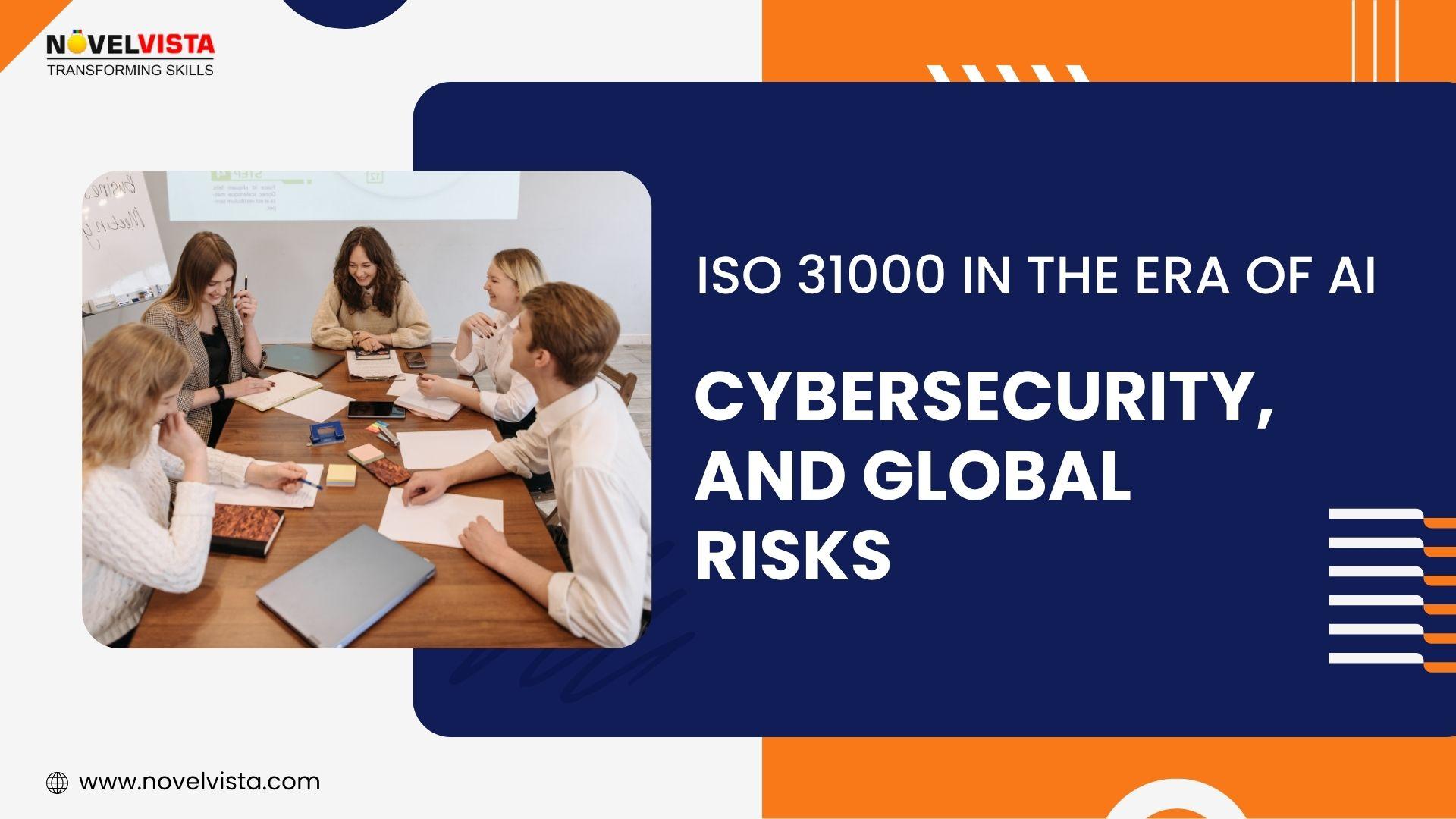ISO 31000 in the Era of AI, Cybersecurity, and Global Risks
In today’s interconnected and fast-changing world, organizations face risks that are more complex, unpredictable, and global in nature than ever before. Artificial Intelligence (AI) is revolutionizing industries, cybersecurity threats are growing in sophistication, and global risks—from climate change to geopolitical instability—are reshaping business landscapes. To navigate these challenges effectively, the ISO 31000 Risk Management framework has emerged as a vital tool for decision-makers seeking resilience and long-term success.
Understanding ISO 31000
ISO 31000 is an international standard that provides guidelines, principles, and a structured approach to risk management. Unlike industry-specific frameworks, ISO 31000 is adaptable to any sector and organization size. Its core aim is to help organizations identify, assess, and manage risks proactively, ensuring that uncertainties are handled in a structured and consistent way.
The standard is built around principles such as:
Integration: Embedding risk management into organizational processes.
Structured and comprehensive approach: Using a systematic method to manage risks.
Customization: Adapting the framework to the organization’s specific context.
Continuous improvement: Regularly reviewing and refining processes.
AI: Opportunities and Risks
Artificial Intelligence offers powerful capabilities for automating processes, analyzing massive datasets, and enabling predictive decision-making. However, AI also brings new categories of risk:
Algorithmic bias: Unchecked AI models can produce discriminatory or unfair outcomes.
Operational dependency: Over-reliance on AI may lead to vulnerabilities if systems fail.
Data privacy concerns: AI often requires vast amounts of personal and sensitive information.
By applying ISO 31000, organizations can evaluate AI-related risks systematically—balancing innovation with safeguards. The framework ensures that AI adoption aligns with ethical principles, legal compliance, and organizational values.
Cybersecurity in a Hyper-Connected World
Cyber threats are no longer limited to IT departments—they pose strategic risks to entire organizations. Ransomware attacks, phishing campaigns, and state-sponsored cyber intrusions have grown more sophisticated and damaging.
ISO 31000 helps organizations:
Identify vulnerabilities across digital infrastructure.
Evaluate likelihood and impact of potential cyber incidents.
Develop mitigation strategies such as multi-layered security protocols, incident response plans, and employee training.
Integrate cybersecurity into enterprise risk management, ensuring it is not treated as a siloed concern.
In essence, ISO 31000 turns cybersecurity from a reactive firefighting effort into a proactive, strategic discipline.
Managing Global Risks
The modern risk landscape is shaped by factors beyond organizational control—climate change, supply chain disruptions, pandemics, and geopolitical tensions. These global risks are interconnected, meaning a single event can have cascading effects.
ISO 31000’s structured process helps organizations:
Contextualize risks by understanding external factors and stakeholder needs.
Analyze interdependencies to anticipate ripple effects.
Develop resilience strategies that go beyond immediate crisis response, such as diversified supply chains or scenario planning.
By integrating global risk awareness into strategic planning, organizations can remain adaptable even in volatile conditions.
The Competitive Advantage of ISO 31000
In the era of AI, cybersecurity challenges, and global uncertainty, ISO 31000 is more than a compliance requirement—it is a strategic enabler. Organizations that embrace the framework can:
Make informed decisions with a clear understanding of potential impacts.
Build stakeholder trust through transparency and preparedness.
Foster a risk-aware culture that encourages proactive problem-solving.
Moreover, ISO 31000 promotes resilience, ensuring that businesses not only survive disruptions but also seize opportunities arising from change.
Conclusion
AI innovation, cybersecurity threats, and global risks define the new reality for organizations worldwide. By adopting ISO 31000 Certification, leaders can move from reactive risk management to a forward-looking, integrated approach. In doing so, they enhance resilience, safeguard reputation, and secure sustainable growth—no matter what uncertainties the future holds.
In today’s interconnected and fast-changing world, organizations face risks that are more complex, unpredictable, and global in nature than ever before. Artificial Intelligence (AI) is revolutionizing industries, cybersecurity threats are growing in sophistication, and global risks—from climate change to geopolitical instability—are reshaping business landscapes. To navigate these challenges effectively, the ISO 31000 Risk Management framework has emerged as a vital tool for decision-makers seeking resilience and long-term success.
Understanding ISO 31000
ISO 31000 is an international standard that provides guidelines, principles, and a structured approach to risk management. Unlike industry-specific frameworks, ISO 31000 is adaptable to any sector and organization size. Its core aim is to help organizations identify, assess, and manage risks proactively, ensuring that uncertainties are handled in a structured and consistent way.
The standard is built around principles such as:
Integration: Embedding risk management into organizational processes.
Structured and comprehensive approach: Using a systematic method to manage risks.
Customization: Adapting the framework to the organization’s specific context.
Continuous improvement: Regularly reviewing and refining processes.
AI: Opportunities and Risks
Artificial Intelligence offers powerful capabilities for automating processes, analyzing massive datasets, and enabling predictive decision-making. However, AI also brings new categories of risk:
Algorithmic bias: Unchecked AI models can produce discriminatory or unfair outcomes.
Operational dependency: Over-reliance on AI may lead to vulnerabilities if systems fail.
Data privacy concerns: AI often requires vast amounts of personal and sensitive information.
By applying ISO 31000, organizations can evaluate AI-related risks systematically—balancing innovation with safeguards. The framework ensures that AI adoption aligns with ethical principles, legal compliance, and organizational values.
Cybersecurity in a Hyper-Connected World
Cyber threats are no longer limited to IT departments—they pose strategic risks to entire organizations. Ransomware attacks, phishing campaigns, and state-sponsored cyber intrusions have grown more sophisticated and damaging.
ISO 31000 helps organizations:
Identify vulnerabilities across digital infrastructure.
Evaluate likelihood and impact of potential cyber incidents.
Develop mitigation strategies such as multi-layered security protocols, incident response plans, and employee training.
Integrate cybersecurity into enterprise risk management, ensuring it is not treated as a siloed concern.
In essence, ISO 31000 turns cybersecurity from a reactive firefighting effort into a proactive, strategic discipline.
Managing Global Risks
The modern risk landscape is shaped by factors beyond organizational control—climate change, supply chain disruptions, pandemics, and geopolitical tensions. These global risks are interconnected, meaning a single event can have cascading effects.
ISO 31000’s structured process helps organizations:
Contextualize risks by understanding external factors and stakeholder needs.
Analyze interdependencies to anticipate ripple effects.
Develop resilience strategies that go beyond immediate crisis response, such as diversified supply chains or scenario planning.
By integrating global risk awareness into strategic planning, organizations can remain adaptable even in volatile conditions.
The Competitive Advantage of ISO 31000
In the era of AI, cybersecurity challenges, and global uncertainty, ISO 31000 is more than a compliance requirement—it is a strategic enabler. Organizations that embrace the framework can:
Make informed decisions with a clear understanding of potential impacts.
Build stakeholder trust through transparency and preparedness.
Foster a risk-aware culture that encourages proactive problem-solving.
Moreover, ISO 31000 promotes resilience, ensuring that businesses not only survive disruptions but also seize opportunities arising from change.
Conclusion
AI innovation, cybersecurity threats, and global risks define the new reality for organizations worldwide. By adopting ISO 31000 Certification, leaders can move from reactive risk management to a forward-looking, integrated approach. In doing so, they enhance resilience, safeguard reputation, and secure sustainable growth—no matter what uncertainties the future holds.
ISO 31000 in the Era of AI, Cybersecurity, and Global Risks
In today’s interconnected and fast-changing world, organizations face risks that are more complex, unpredictable, and global in nature than ever before. Artificial Intelligence (AI) is revolutionizing industries, cybersecurity threats are growing in sophistication, and global risks—from climate change to geopolitical instability—are reshaping business landscapes. To navigate these challenges effectively, the ISO 31000 Risk Management framework has emerged as a vital tool for decision-makers seeking resilience and long-term success.
Understanding ISO 31000
ISO 31000 is an international standard that provides guidelines, principles, and a structured approach to risk management. Unlike industry-specific frameworks, ISO 31000 is adaptable to any sector and organization size. Its core aim is to help organizations identify, assess, and manage risks proactively, ensuring that uncertainties are handled in a structured and consistent way.
The standard is built around principles such as:
Integration: Embedding risk management into organizational processes.
Structured and comprehensive approach: Using a systematic method to manage risks.
Customization: Adapting the framework to the organization’s specific context.
Continuous improvement: Regularly reviewing and refining processes.
AI: Opportunities and Risks
Artificial Intelligence offers powerful capabilities for automating processes, analyzing massive datasets, and enabling predictive decision-making. However, AI also brings new categories of risk:
Algorithmic bias: Unchecked AI models can produce discriminatory or unfair outcomes.
Operational dependency: Over-reliance on AI may lead to vulnerabilities if systems fail.
Data privacy concerns: AI often requires vast amounts of personal and sensitive information.
By applying ISO 31000, organizations can evaluate AI-related risks systematically—balancing innovation with safeguards. The framework ensures that AI adoption aligns with ethical principles, legal compliance, and organizational values.
Cybersecurity in a Hyper-Connected World
Cyber threats are no longer limited to IT departments—they pose strategic risks to entire organizations. Ransomware attacks, phishing campaigns, and state-sponsored cyber intrusions have grown more sophisticated and damaging.
ISO 31000 helps organizations:
Identify vulnerabilities across digital infrastructure.
Evaluate likelihood and impact of potential cyber incidents.
Develop mitigation strategies such as multi-layered security protocols, incident response plans, and employee training.
Integrate cybersecurity into enterprise risk management, ensuring it is not treated as a siloed concern.
In essence, ISO 31000 turns cybersecurity from a reactive firefighting effort into a proactive, strategic discipline.
Managing Global Risks
The modern risk landscape is shaped by factors beyond organizational control—climate change, supply chain disruptions, pandemics, and geopolitical tensions. These global risks are interconnected, meaning a single event can have cascading effects.
ISO 31000’s structured process helps organizations:
Contextualize risks by understanding external factors and stakeholder needs.
Analyze interdependencies to anticipate ripple effects.
Develop resilience strategies that go beyond immediate crisis response, such as diversified supply chains or scenario planning.
By integrating global risk awareness into strategic planning, organizations can remain adaptable even in volatile conditions.
The Competitive Advantage of ISO 31000
In the era of AI, cybersecurity challenges, and global uncertainty, ISO 31000 is more than a compliance requirement—it is a strategic enabler. Organizations that embrace the framework can:
Make informed decisions with a clear understanding of potential impacts.
Build stakeholder trust through transparency and preparedness.
Foster a risk-aware culture that encourages proactive problem-solving.
Moreover, ISO 31000 promotes resilience, ensuring that businesses not only survive disruptions but also seize opportunities arising from change.
Conclusion
AI innovation, cybersecurity threats, and global risks define the new reality for organizations worldwide. By adopting ISO 31000 Certification, leaders can move from reactive risk management to a forward-looking, integrated approach. In doing so, they enhance resilience, safeguard reputation, and secure sustainable growth—no matter what uncertainties the future holds.
1 Kommentare
·0 Geteilt
·9 Ansichten
·0 Bewertungen







